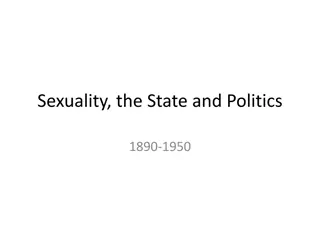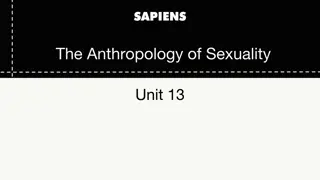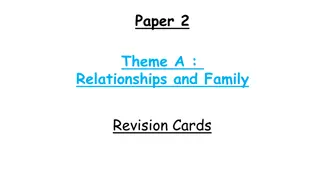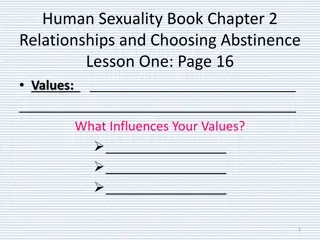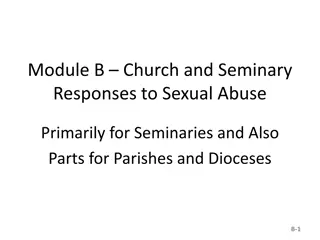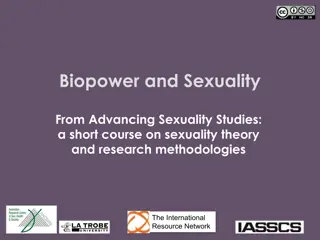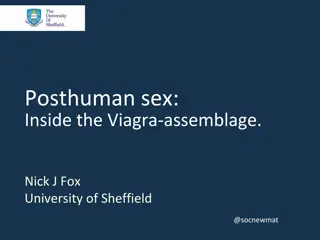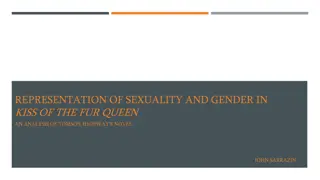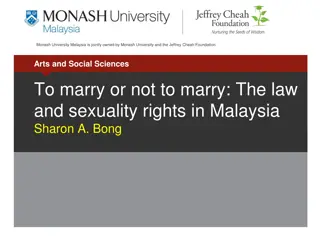
Unveiling Victorian Sexuality: Exploring Attitudes and Identities
Delve into the intricate web of Victorian sexuality, from historical perspectives and societal fears to the emergence of queer theory. Discover how changing attitudes and the influence of science shaped perceptions of sex and identity during this transformative period.
Download Presentation

Please find below an Image/Link to download the presentation.
The content on the website is provided AS IS for your information and personal use only. It may not be sold, licensed, or shared on other websites without obtaining consent from the author. If you encounter any issues during the download, it is possible that the publisher has removed the file from their server.
You are allowed to download the files provided on this website for personal or commercial use, subject to the condition that they are used lawfully. All files are the property of their respective owners.
The content on the website is provided AS IS for your information and personal use only. It may not be sold, licensed, or shared on other websites without obtaining consent from the author.
E N D
Presentation Transcript
Overview Approaches Victorian attitudes Masturbation fears Homosexuality Sexology Conclusion
Approaches Increasingly informed by queer theory , a theoretical approach which emanates from literary and critical studies Move away from the reclamation school which sought to recover the stories of (usually) male homosexuals for the historical record Queer theorists argue that sexual identity constructions are arbitrary Other markers of identity such as race and class should be used Emerged from radical AIDS activism in the US in the 1980s
Nameless Offences Harry Cocks uses theory as an analytical framework for mapping homosexual desire in the period. Argues cultural oppression fostered a language of the closet . In law homosexuality was often nameless and this created a space of impunity He argues this existed long before the so called watershed of the 1880s and 1890s
Victorian attitudes Many attitudes emerged in 18thcentury: Fears of the dire effects of masturbation Hospitals for sufferers of sexual transmitted diseases Campaigns against prostitution Vice societies Ideologies of male and female behaviour
Symptoms of the tertiary phase of syphillis, 19th century. A patient afflicted with sores and ulcers to the neck and face, including one which has destroyed part of the nasal cartilage. Estimated that 10% of population had syphilis by 1860s
Sex and identity Victorians embraced view that an individual's sex and sexuality form the most basic core of their identity Towards the beginning of the eighteenth century, there emerged a political, economic, and technical incitement to talk about sex (Foucault)
Changing attitudes Shift in attitudes and behaviour from around 1870 Population began to decline Opposition to Contagious Diseases Acts led to movement for repeal Rise of feminism and focus on women s rights Application of science to study of sex
Control of male urges Victorian social moralists proposed socio-medical discourse based on masculine self-control in support of the bourgeois ideal of domestic life. Idea of the body as a closed system of energy so male sexual 'expenditure' and especially 'excess' (spermatorrhea) were said to cause enfeeblement. Men counselled to conserve vital health by avoiding fornication, masturbation and nocturnal emissions and by rationing sex within marriage. That insanity arises from masturbation is now beyond a doubt
Male anti-masturbation device, 1880-1920 Anti-masturbation devices
Control of female sexual behaviour Ailments afflicting adolescent girls said to signify abnormal sexual excitation. Some doctors used clitoridectomy to prevent sexual pleasure Dr Isaac Baker Brown advocated clitoridectomy to eradicate female self-abuse But was considered assault on British womanhood to argue that they practised self- abuse Was distaste at mutilation
Homosexuality Later nineteenth century witnessed visible increase in homosexuality Term homosexual was invented in 1869, becoming part of normal usage by the 1880s Lesbian was a term largely unknown until the 1890s. Sodomy was a capital offence until 1861 and between 1800 and 1835 80 men were hanged for this crime against nature. Women were exempted from the legal sanctions that applied to men
Anne Lister, Shibden Hall, Halifax wrote her diary in code to keep her affections for other women secret
Vera Holmes diaries, photographs and papers document her bohemian life - as a cross-dressing actress, suffragette chauffeur to the Pankhursts and servicewoman overseas during the First World War and her romantic relationships with women.
Emergence of gay subculture Decadence movement include the promotion of 'Greek' or Platonic relationships by some university dons Allure to the forbidden and deviant Rise of aesthetic movement Exposure of male brothel in the Cleveland Street scandal in 1889 Trials of Oscar Wilde in 1895
Aubrey Beardsley (1872-98)
Sketch of Charles Hammond operator of male brothel in Clevland St. He escaped prosecution
Oscar Wilde and Lord Alfred Douglas
Sexology Questions of sexual identity subject to speculative and would-be scientific investigation, dubbed sexology (1902). In A Problem in Greek Ethics and A Problem in Modern Ethics John Addington Symonds suggested that man-boy love had been encouraged by the ancient Greeks Havelock Ellis attempted a detailed classification of 'normal' and 'perverse' sexual practices. Identified 'third' or 'intermediate' sex, for which Ellis used the term 'sexual inversion'. Edward Carpenter in, The Intermediate Sex challenged Victorian sexual ideology and viewed comradeship between men as an essential ingredient of socialist society Lesbian and Sapphic came into use as terms for female relationships
Conclusion Sex and sexuality in Victorian period in state of transition and flux Changing attitudes to sexual deviance Application of science to study of sexuality Stereotypical views of attitudes to sex need to be challenged

